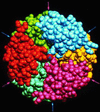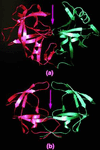Symmetry, stability, and dynamics of multidomain and multicomponent protein systems
- PMID: 8962033
- PMCID: PMC34468
- DOI: 10.1073/pnas.93.25.14243
Symmetry, stability, and dynamics of multidomain and multicomponent protein systems
Abstract
Symmetry is commonly observed in many biological systems. Here we discuss representative examples of the role of symmetry in structural molecular biology. Point group symmetries are observed in many protein oligomers whose three-dimensional atomic structures have been elucidated by x-ray crystallography. Approximate symmetry also occurs in multidomain proteins. Symmetry often confers stability on the molecular system and results in economical usage of basic components to build the macromolecular structure. Symmetry is also associated with cooperativity. Mild perturbation from perfect symmetry may be essential in some systems for dynamic functions.
Figures






References
-
- Schulz G E, Schirmer R H. Principles of Protein Structure. New York: Springer; 1979.
-
- Creighton T E. Proteins: Structures and Molecular Properties. New York: Freeman; 1993.
-
- Wlodawer A, Miller M, Jaskolski M, Sathyanarayana B K, Baldwin E, Weber I T, Selk L M, Clawson L, Schneider J, Kent S B H. Science. 1989;245:616–621. - PubMed
-
- Lapatto P, Blundell T, Hemmings A, Overington J, Wildersprin A, Wood S, Merson J R, Whittle P J, Danley D E, Geoghegan K F, Hawrylik S J, Lee S E, Scheld K G, Hobart P M. Nature (London) 1989;342:299–302. - PubMed
-
- Bax B, Lapatto L, Nalini V, Driessen H, Lindley P F, Mahadevan D, Blundell T L, Slingsby C. Nature (London) 1990;347:776–780. - PubMed
Publication types
MeSH terms
Substances
Grants and funding
LinkOut - more resources
Full Text Sources
Other Literature Sources

